
Scott C. France - University of Louisiana at Lafayette
May 16, 2017
A dark world of color. Video courtesy of the NOAA Office of Ocean Exploration and Research, Mountains in the Deep: Exploring the Central Pacific Basin. Download larger version (mp4, 28.2 MB).
I am often asked why many deep-sea corals are so colorful in a completely dark environment. To better understand this, we must first understand what light and color are. For the purposes of this article, light refers to the visible part of the electromagnetic spectrum that the human eye can detect. Some animals have eyes that can detect parts of the electromagnetic spectrum that we cannot – for example, ultraviolet or infrared light. White light comprises all of the wavelengths of the visible spectrum. If we could separate the wavelengths of white light, we would see a rainbow of colors, as shown by passing white light through a prism.
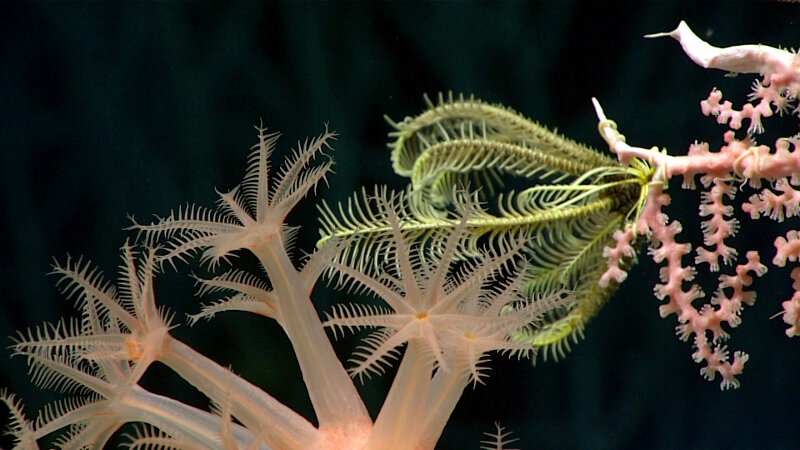
On Dive 03, we found a veritable coral forest. The colors on this dive were phenomenal. In the foreground, the large polyps of an Anthomastus contrast with a yellow crinoid attached to a pink precious coral. Image courtesy of the NOAA Office of Ocean Exploration and Research, Mountains in the Deep: Exploring the Central Pacific Basin. Download larger version (jpg, 1.2 MB).
Color is due to the reflection of different wavelengths of visible light. When white light strikes an object, some wavelengths are absorbed. Wavelengths that are not absorbed reflect back to our eyes. That is what we perceive as the color of that object.
When we are operating in the deep sea, remotely operated vehicle Deep Discoverer (D2) carries lights that allow us to detect color. It is worth keeping in mind that the color of the animals and habitat we perceive is not what the animals living there are seeing. They perceive their environment differently, as there is no natural source of white light equivalent to what D2 emits.
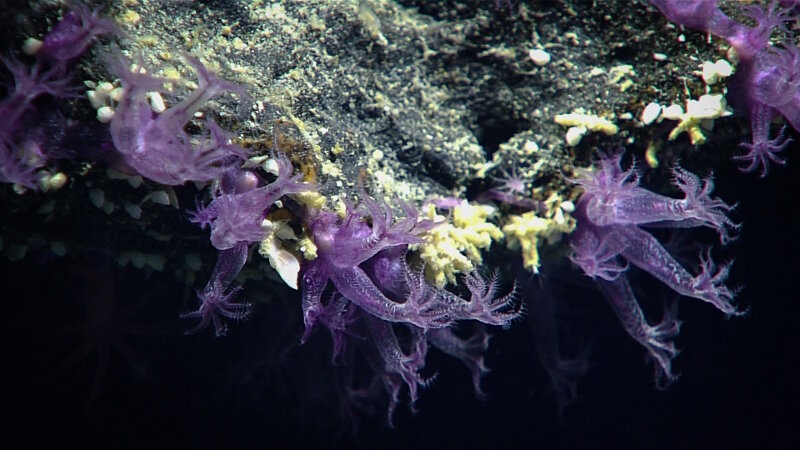
These bright purple octocorals from Dive 04 grow like ribbons upon the rock as opposed to branching colonies. Image courtesy of the NOAA Office of Ocean Exploration and Research, Mountains in the Deep: Exploring the Central Pacific Basin.. Download larger version (jpg, 1.4 MB).
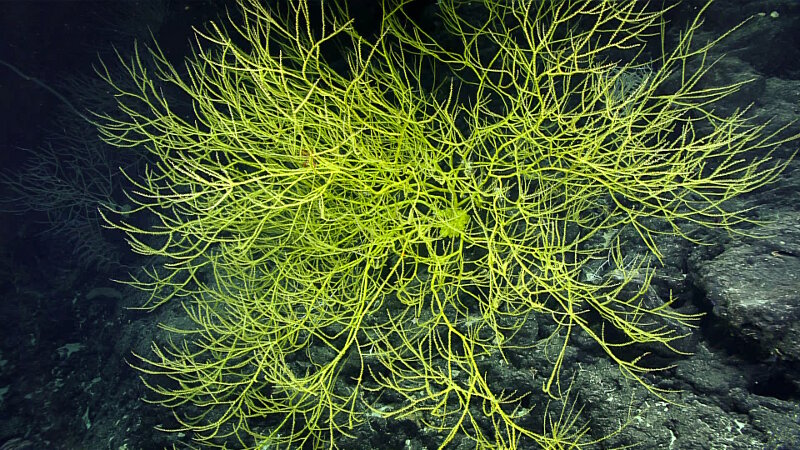
This large, vibrantly yellow bamboo coral seen on Dive 04 was nearly equal in size to ROV Deep Discoverer. Image courtesy of the NOAA Office of Ocean Exploration and Research, Mountains in the Deep: Exploring the Central Pacific Basin.. Download larger version (jpg, 2.7 MB).
Many octocorals have in their tissues or bound to their skeletons pigment molecules, which absorb certain wavelengths of light. Carotenoids are the most common. They generate bright coloration in yellow, orange, and deep red. Variation in the color resulting from the presence of carotenoids is also a function of how the molecules are arranged. Carotenoids are usually bound to proteins or other molecules, or even to the calcium carbonate skeleton. Physical and chemical properties of the carotenoid can change when bound, potentially affecting what part of the light spectrum is absorbed, thus altering its color.
While the many different types of carotenoids may result in various bright colors, the production of color itself is not the purpose. In photosynthetic organisms that produce carotenoids, the carotenoids are used for light absorption and photoprotection. In octocorals, it has been suggested carotenoids may function as antioxidants, by strengthening the immune system, and as antibacterial compounds.
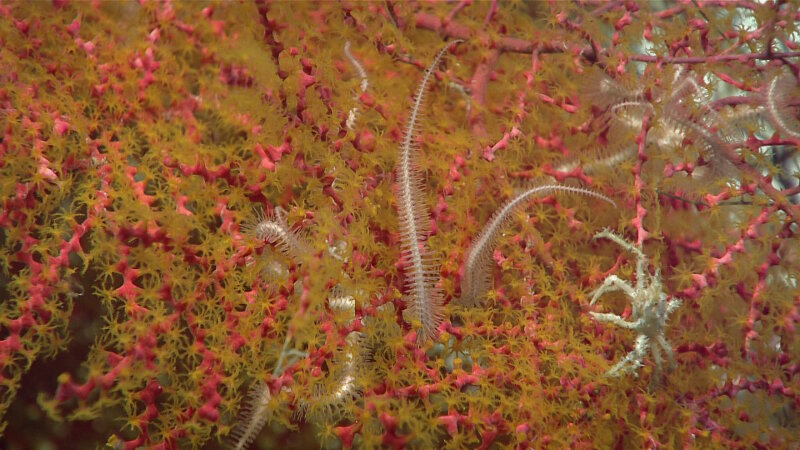
Seen on Dive 10, this Swiftia sea fan has polyps of a different color than the branches. Notice the soft tissue is a bright yellow and the skeletal features are a bright red. Brittle stars and a crab can also be seen in this image. Image courtesy of the NOAA Office of Ocean Exploration and Research, Mountains in the Deep: Exploring the Central Pacific Basin.. Download larger version (jpg, 1.5 MB).
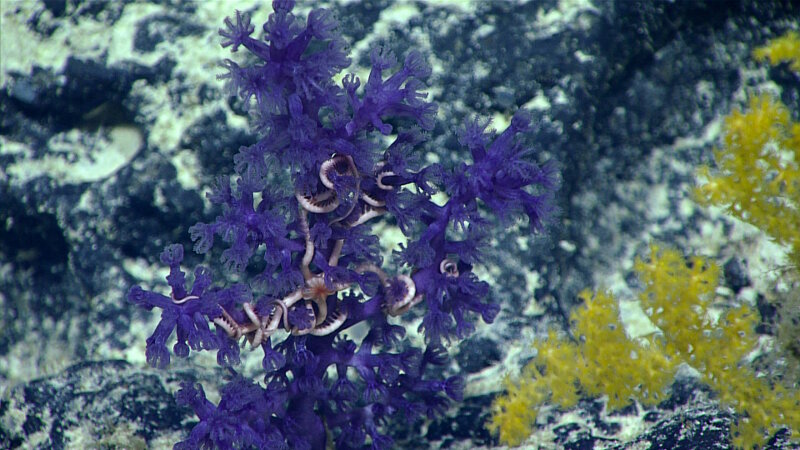
On Dive 11, we found this deep purple Victorgorgia next to a yellow Acanthogorgia. Pink brittle star arms can be seen wrapped in the branches. Image courtesy of the NOAA Office of Ocean Exploration and Research, Mountains in the Deep: Exploring the Central Pacific Basin.. Download larger version (jpg, 1.4 MB).
Octocorals cannot produce carotenoids; they must obtain them from their diet. Types of food may influence coloration because different prey may have different carotenoids. Marine bacteria contain carotenoids. Therefore, differences in compositions of the bacterial community associated with a coral may lead to color variation.
Thus, because we are visual creatures, we may assume that color variation and patterns are always associated with visual cues. But deep-sea corals display colors in the dark for a myriad of reasons unrelated to visual cues. Regardless of the function, we can simply enjoy them for their dramatic colorful beauty.

The subtle pink of the mouths of these bamboo coral polyps contrast with the white of the polyp body and the bright red of the Asteronyx brittle star. Image courtesy of the NOAA Office of Ocean Exploration and Research, Mountains in the Deep: Exploring the Central Pacific Basin. Download larger version (jpg, 742 KB).